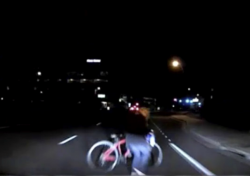
— The death of Elaine Herzberg in March 2018 was caused by a self-driving vehicle system that could not see "jaywalkers" and failed to classify Herzberg as a pedestrian.
Herzberg, 49, was killed when the Volvo SUV struck her as she ignored the crosswalk signs and walked her bike onto the road. The bike had no side reflectors and the front and rear reflectors faced away from the self-driving Volvo.
Additionally, Herzberg's toxicology tests came back positive for marijuana and methamphetamine.
In a final report from the National Safety Transportation Board (NTSB), conclusions reached by investigators match nightmare scenarios predicted by dozens of safety advocates who claim consumers are being treated as lab rats when self-driving cars are on the roads.
In the NTSB report, the 2017 Volvo XC90 that hit Herzberg had its Volvo collision avoidance system deactivated at the time of the crash.
The SUV was factory-equipped with several driver assistance systems offered by Volvo, but those features were disabled because Uber had equipped the Volvo with its "Advanced Technologies Group (ATG) developmental automated driving system (ADS)."
When the XC90 SUV was operated in manual mode and controlled by a human driver, all the Volvo driver assistance components were activated, but those Volvo components were automatically disabled when the SUV was operated in autonomous mode.
Federal investigators found the Uber software completely failed to accurately detect Herzberg as a pedestrian and couldn't predict which path she was taking while crossing the road.
According to the NTSB report, the vehicle was traveling 44 mph 5.8 seconds before the Uber struck Herzberg.
— At 5.6 seconds before impact, the self-driving Uber classified Herzberg and her bicycle as a "vehicle" that wasn't on the same path as the Volvo SUV.
— At 5.2 seconds before impact, the vehicle was traveling 45 mph and Herzberg was classified as a non-moving "other" object that wasn't on the path of the SUV.
— The self-driving system classified Herzberg and her bike as a "vehicle" 4.2 seconds before impact, a vehicle that wasn't on the same path as the Volvo.
— Then 3.9 seconds before the crash, the self-driving Uber classified Herzberg as a "vehicle" that wasn't on the same path as the SUV, but the system predicted the vehicle's path as traveling in the left lane adjacent to the Uber vehicle.
— Things really go haywire between 3.8 and 2.7 seconds before impact when the self-driving system classified Herzberg as a "vehicle" then reclassified her as "other" several times. At some points she was classified as "unknown" then back to a "vehicle" that wasn't moving in the road. However, the system switched her position as "traveling in the left through lane."
— At 2.6 seconds before impact, Uber's self-driving system classified Herzberg and her bike as only a "bicycle" that was static on the road and not on the same path as the SUV.
— Then 2.5 second before impact, Herzberg was classified as a "bicycle" in the left lane and not on the same path as the SUV.
— At 1.5 seconds, Herzberg and her bike had the classification of an "unknown" object that wasn't moving but was partially on the same path as the Uber SUV.
— That classification changed 1.2 seconds before impact when the system detected a "bicycle" on the same path as the SUV, then 0.2 seconds before the crash the system classified Herzberg and her bike as only a "bicycle" fully on the same path as the SUV.
The system also indicated it was no longer possible to steer around Herzberg but a plan for the vehicle to slow down was initiated. It was at this time an auditory alert was provided to the human driver who finally took control of the steering wheel and deactivated the self-driving system.
Based on video from the Volvo SUV (below), the human driver had her eyes down and off the road until the auditory alert at 0.2 seconds before impact.
The NTSB report says the self-driving system never classified Herzberg as a pedestrian, and she was not classified as a jaywalking pedestrian because "the system design did not include consideration for jaywalking pedestrians."
"Instead, the system had initially classified her as an other object which are not assigned goals. As the ADS changed the classification of the pedestrian several times—alternating between vehicle, bicycle, and an other—the system was unable to correctly predict the path of the detected object." - NTSB final report
Uber and Volvo say multiple changes have been made to the self-driving test vehicles since the death of Elaine Herzberg, and both companies claim the same situation on a road today will be avoided.
Uber told NTSB investigators that new software would detect and correctly classify the pedestrian 4.5 seconds before the time of impact. In addition to correctly classifying the "object" as a pedestrian, Uber says new software will correctly predict the path of a pedestrian crossing a street and if the pedestrian is on a collision path with the self-driving vehicle.
The system allegedly will also initiate controlled braking more than 4 seconds before the original time of impact.




